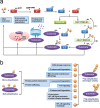Targeting the ubiquitination/deubiquitination process to regulate immune checkpoint pathways
- PMID: 33479196
- PMCID: PMC7819986
- DOI: 10.1038/s41392-020-00418-x
Targeting the ubiquitination/deubiquitination process to regulate immune checkpoint pathways
Abstract
The immune system initiates robust immune responses to defend against invading pathogens or tumor cells and protect the body from damage, thus acting as a fortress of the body. However, excessive responses cause detrimental effects, such as inflammation and autoimmune diseases. To balance the immune responses and maintain immune homeostasis, there are immune checkpoints to terminate overwhelmed immune responses. Pathogens and tumor cells can also exploit immune checkpoint pathways to suppress immune responses, thus escaping immune surveillance. As a consequence, therapeutic antibodies that target immune checkpoints have made great breakthroughs, in particular for cancer treatment. While the overall efficacy of immune checkpoint blockade (ICB) is unsatisfactory since only a small group of patients benefited from ICB treatment. Hence, there is a strong need to search for other targets that improve the efficacy of ICB. Ubiquitination is a highly conserved process which participates in numerous biological activities, including innate and adaptive immunity. A growing body of evidence emphasizes the importance of ubiquitination and its reverse process, deubiquitination, on the regulation of immune responses, providing the rational of simultaneous targeting of immune checkpoints and ubiquitination/deubiquitination pathways to enhance the therapeutic efficacy. Our review will summarize the latest findings of ubiquitination/deubiquitination pathways for anti-tumor immunity, and discuss therapeutic significance of targeting ubiquitination/deubiquitination pathways in the future of immunotherapy.
Conflict of interest statement
The authors declare no competing interests.
Figures




References
Publication types
MeSH terms
Substances
LinkOut - more resources
Full Text Sources
Other Literature Sources
Medical
Research Materials

